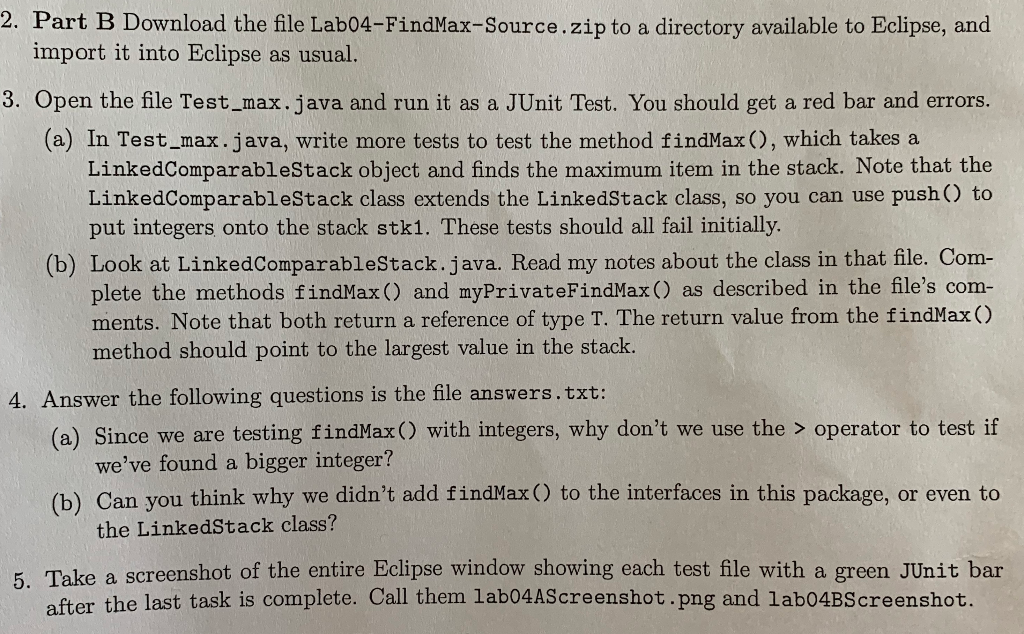Question
package testMax; import static org.junit.Assert.*; import org.junit.Assert; import org.junit.Before; import org.junit.Test; import stackPackage.*;//AJF public class Test_max { LinkedComparableStack stk1; @Before public void setUp() throws Exception

package testMax;
import static org.junit.Assert.*;
import org.junit.Assert; import org.junit.Before; import org.junit.Test;
import stackPackage.*;//AJF
public class Test_max {
LinkedComparableStack stk1; @Before public void setUp() throws Exception { stk1 = new LinkedComparableStack(); }
@Test(expected = StackUnderflowException.class) //AJF public void test_findMax_on_an_emptyStack() { stk1.findMax(); }
}
********************************
package stackPackage;
public class LinkedComparableStackextends Comparable> extends LinkedStack {
public LinkedComparableStack() {
// constructor uses superclass constructor method
super();
}
/* AJF:
* In this class, if A and B are both type T,
* then we can use A.compareTo(B) for comparing A to B.
* The result will be 0 if A is the same as B,
* positive if A is greater than B,
* and negative if A is less than B.
* (So, A.compareTo(B) basically does A-B.)
*
* Note the "extends Comparable" bit above, which makes
* sure generic type T is a comparable type.
*
*/
/*
* AJF: I recommend you use findMax() as a public wrapper
* which calls a private *recursive* function myPrivateFindMax
* as indicated below.
*/
public T findMax() throws StackUnderflowException{
}
/*
* AJF: The reason myPrivateFindMax is private, is because
* the intention is for it to be called with top as the
* initial parameter, and top is protected.
*/
private T myPrivateFindMax(LLNode current) {
}
}
***********************
package stackPackage;
public class LinkedStack
protected LLNode
public LinkedStack() {
top = null;
}
public void push(T element)
// Places element at the top of this stack.
{
LLNode
newNode.setLink(top);
top = newNode;
}
public void pop()
// Throws StackUnderflowException if this stack is empty,
// otherwise removes top element from this stack.
{
if (!isEmpty()) {
top = top.getLink();
} else
throw new StackUnderflowException("Pop attempted on an empty stack.");
}
public T top()
// Throws StackUnderflowException if this stack is empty,
// otherwise returns top element from this stack.
{
if (!isEmpty())
return top.getInfo();/* LinkedStack stk;
@Before
public void setUp() throws Exception {
stk = new LinkedStack
}
*/
else
throw new StackUnderflowException("Top attempted on an empty stack.");
}
public boolean isEmpty()
// Returns true if this stack is empty, otherwise returns false.
{
if (top == null)
return true;
else
return false;
}
//AJF
private String printFromBottom(LLNode
// recursively add each string from bottom of stack
{
String stringSoFar = "";
if (current.getLink() != null) {
// more links to explore
stringSoFar += printFromBottom(current.getLink());
}
stringSoFar += current.getInfo().toString();
stringSoFar += "|";
return(stringSoFar);
}
//AJF
public String toString()
// returns a string containing contents of the stack from bottom to top.
{
if (isEmpty()) {
return "Empty Stack";
}
String returnString = "";
returnString += "bottom|";
returnString += printFromBottom(top);
returnString += "top";
return returnString;
}
public int sizeIs() {
LLNode
int size = 0;
if (current == null) {
return 0;
}
size++;
while (current.getLink() != null) {
size++;
current = current.getLink();
}
return size;
}
public void clear() {
top = null;
}
}
2. Part B Download the file Lab04-FindMax-Source.zip to a directory available to Eclipse, and import it into Eclipse as usual. 3. Open the file Test_max.java and run it as a JUnit Test. You should get a red bar and errors. (a) In Test max.java, write more tests to test the method findMax ), which takes a LinkedComparableStack object and finds the maximum item in the stack. Note that the LinkedComparableStack class extends the LinkedStack class, so you can use pushO to put integers onto the stack stk1. These tests should all fail initially (b) Look at LinkedComparableStack. java. Read my notes about the class in that file. Com- plete the methods findMax) and myPrivateFindMax) as described in the ile's com- ments. Note that both return a reference of type T. The return value from the findMax() method should point to the largest value in the stack. 4. Answer the following questions is the file answers.txt: (a) Since we are testing findMax() with integers, why don't we use the > operator to test if we've found a bigger integer? (b) Can you think why we didn't add findMax() to the interfaces in this package, or even to the LinkedStack class? 5, Take a screenshot of the entire Eclipse window showing each test file with a green JUnit bar after the last task is complete. Call them lab04AScreenshot png and lab04BScreenshot. 2. Part B Download the file Lab04-FindMax-Source.zip to a directory available to Eclipse, and import it into Eclipse as usual. 3. Open the file Test_max.java and run it as a JUnit Test. You should get a red bar and errors. (a) In Test max.java, write more tests to test the method findMax ), which takes a LinkedComparableStack object and finds the maximum item in the stack. Note that the LinkedComparableStack class extends the LinkedStack class, so you can use pushO to put integers onto the stack stk1. These tests should all fail initially (b) Look at LinkedComparableStack. java. Read my notes about the class in that file. Com- plete the methods findMax) and myPrivateFindMax) as described in the ile's com- ments. Note that both return a reference of type T. The return value from the findMax() method should point to the largest value in the stack. 4. Answer the following questions is the file answers.txt: (a) Since we are testing findMax() with integers, why don't we use the > operator to test if we've found a bigger integer? (b) Can you think why we didn't add findMax() to the interfaces in this package, or even to the LinkedStack class? 5, Take a screenshot of the entire Eclipse window showing each test file with a green JUnit bar after the last task is complete. Call them lab04AScreenshot png and lab04BScreenshotStep by Step Solution
There are 3 Steps involved in it
Step: 1

Get Instant Access to Expert-Tailored Solutions
See step-by-step solutions with expert insights and AI powered tools for academic success
Step: 2

Step: 3

Ace Your Homework with AI
Get the answers you need in no time with our AI-driven, step-by-step assistance
Get Started


